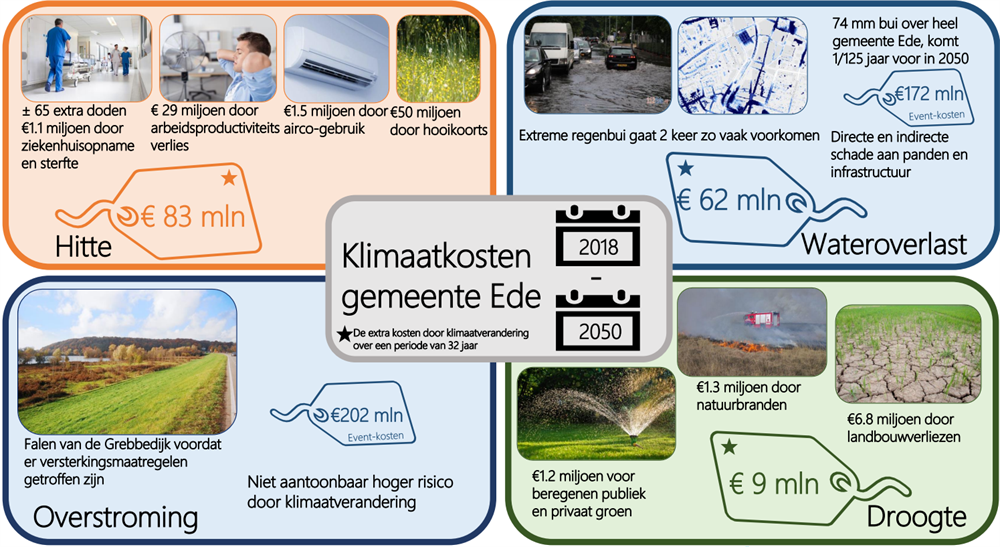Climate Damage Assessor helps municipality of Ede to make choices regarding climate adaptation
The municipality of Ede had already had the financial consequences of climate change for its territory calculated in 2018, shortly after the development of their Climate Impact Atlas. Why has Ede still used the Climate Damage Assessor, in addition to the Climate Impact Atlas? How have they used the tool? And what were the outcomes?
What was the reason?
The maps in a climate stress test can provide a good picture of the direct and indirect consequences of climate change. Which locations are particularly prone to extreme heat, drought, or waterlogging? Does an area run a high or a low risk of heat stress? Which locations are at risk of severe subsidence? However, maps do not sufficiently demonstrate the urgency of such consequences and to some people, they will remain rather abstract. The Climate Damage Assessor gives a more concrete idea of the consequences, by visualising the costs they entail. This tool addresses the seriousness of the changing climate from a financial perspective. This makes it easier to decide which measures would be effective: what would a measure cost? And what would the benefits be, in other words: what costs could the measure prevent?
How has Ede used the Climate Damage Assessor?
In early 2018, the Climate Damage Assessor was not yet available as an online tool. Nonetheless, the municipality wished to have the financial consequences of climate damage for Ede calculated. This was shortly after the development of the Ede Climate Impact Atlas, which also constitutes their stress test. They then had an estimate made of the additional costs that climate change would entail up until 2050. They intended to weigh up these costs and the costs of measures. As the municipality of Ede comprises a large rural expanse, the calculations covered not only the damage in urban areas. For example, they also charted agricultural losses and the costs of nature fires.
Who were involved in the study?
The Climate Adaptation Services Foundation CAS has determined the climate costs on the basis of literature research. The municipal authorities have conducted interviews with Wageningen Environmental Research and the Gelderland-Midden Security and Health Region to determine the damage resulting from nature fires.
What were the results?
The infographic below sets out all the additional costs entailed in climate change for the municipality of Ede for the period 2018 – 2050. This makes it immediately clear that climate change will have a huge impact in terms of all four issues. Waterlogging caused by extreme precipitation usually involves direct costs. Drought and heat involve indirect costs: labour productivity tends to decrease, as does crop yield, whilst the risk of nature fires increases. As yet, the municipality has not quite been aware of such indirect costs.

Additional costs entailed in climate change for the municipality of Ede for the period 2018 - 2050
What has Ede done with the results?
The municipality of Ede has used the results in its risk dialogues and shared them in the regional collaborative Vallei and Eem Water Platform. Furthermore, it has used the results to embed the issue of climate adaptation on a wider scale within the municipal organisation. Previously, the topic was only addressed by staff involved in the (waste) water chain. Finally, the results will help the municipality to determine which topics have highest priority: How do we tackle waterlogging? What is the first measure we should take to combat heat stress? How can we reduce the risk of nature fires? And what can we do about the impact on agriculture?
Lessons to be learned
In Ede, the authorities have learned the following from the Climate Damage Assessor:
- In addition to the Climate Impact Atlas and the NAS conceptual diagrams, the Climate Damage Assessor is a useful tool to visualise the consequences of climate change. This also emerges from a survey conducted by the Vallei and Eem Water Platform.
- These tools foster mutual understanding in discussions about climate change and its impact.
- The changing climate is affecting several sectors. This adds to the importance of tackling the consequences in concert!
- The costs determined by the Climate Damage Assessor provide a rough picture. For several issues, the municipality would like a more accurate cost estimate. However, in some cases, the outline provides sufficient information to make choices.
Contact person
Koen Claassen
koen.claassen@ede.nl
